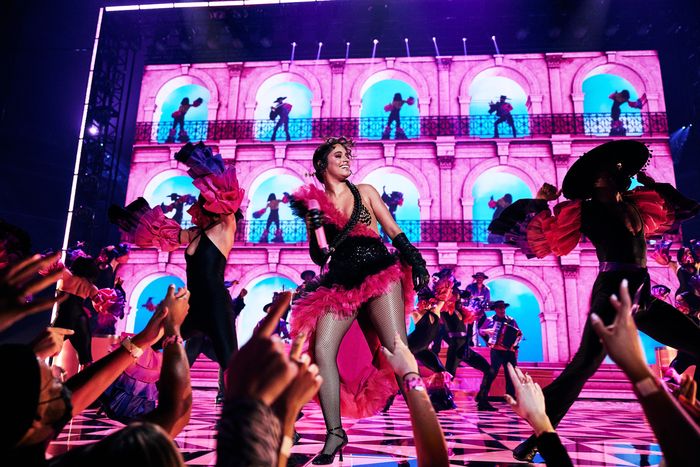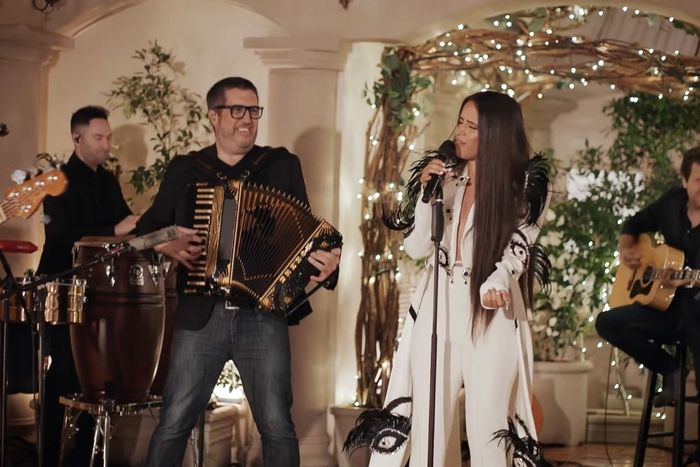
The other day, Edgar Barrera noticed something surprising: A salsa song was climbing the global Spotify charts. It was “Bam Bam,” the single Camila Cabello released last month off her third solo album, Familia, now out in full. American listeners may not be able to identify the salsa influences at first, but Barrera, who co-wrote and co-produced the song, intended it that way from the start. Seeing “Bam Bam” climb the charts (it’s also at No. 13 on the Billboard Global 200, a testament to its resonance outside the U.S.) is evidence of something Barrera already knew: “It’s pushing culture,” he says.
That’s true not just of “Bam Bam,” but of a number of songs on Familia, from the mariachi-based “La Buena Vida” to the reggaeton-influenced “Hasta Los Dientes” — the latter of which is sung completely in Spanish, as is “Celia.” Barrera, a Mexican producer and reigning Latin Grammy winner for Producer of the Year, worked on all four of those songs alongside Cabello and her executive producer, Ricky Reed. Cheche Alara, an Argentinian producer and arranger who’s also won multiple Latin Grammys, worked on “Bam Bam” and “La Buena Vida” as well. Speaking to Elle Mexico, Cabello credited Barrera and Alara in particular with how “natural” it felt to incorporate Latin musical styles into the album. “Para mí se trataba de crear música latina con gente de origen latino,” Cabello told the magazine — that to her, it came down to making Latin music with Latinx people.
The resulting album makes those traditional styles sound like they belong in mainstream pop music by incorporating styles like hip-hop into “La Buena Vida” and ’80s dance-pop into “Hasta Los Dientes” and placing those tracks alongside more straightforward pop songs like “psychofreak” and “Quiet.” As much as Barrera and Alara brought to the process, they claim it all goes back to Cabello’s roots, which she wanted to showcase throughout the project. “She’s half-Cuban, half-Mexican, and 100 percent American, and it’s a wonderful blend of cultures,” Alara says. “What I love about Camila is that she exemplifies how you can truthfully blend all these things together without ignoring any of these factors.” Speaking to Vulture, Alara and Barrera broke down how they brought Latin musical influences to Familia.
Cabello started with the Latin music she liked
As she was planning Familia, Cabello enjoyed listening to Colombian singer-songwriter Camilo’s 2021 album Mis Manos, which Barrera produced. That prompted her to reach out to Barrera, who quickly learned they shared a musical language. “We started playing music, and we played a lot of songs that she loved from her childhood,” he says. “It was really funny because they were songs that I also listened to when I was a little kid.” Barrera specifically remembers bonding over the bolero trios Cabello’s grandmother had enjoyed, like Los Panchos and Javier Solis, along with mariachi music and the ranchera musician José Alfredo Jiménez. “We went really way back into the culture,” Barrera says. Shortly after Barrera became involved, Cabello and Reed also reached out to Alara out of a similar interest in his work.
Familia’s Latin-pop fusion was based in tradition
Many of the sonic ideas began with Cabello, like blending mariachi music with English lyrics on “La Buena Vida.” According to Barrera, who has worked on other mariachi songs, “La Buena Vida” uses a particular huapango rhythm that’s become less common in Mexican music. “Going back to that was just like, ‘Are you sure?’” he says. “It’s something completely new and fresh.” To make “La Buena Vida” work as a song, Alara insisted to Reed that they bring a full mariachi band into the studio to perform live despite the ongoing pandemic. “Mariachi music, like most folk music from any region in the world, needs to be performed live,” Alara says. “It comes from the people; it’s very organic. So I had to get that energy in the room.” The same went for “Bam Bam,” which featured percussion instruments playing off each other as part of a salsa-pop fusion. “Everyone was dancing,” Alara remembers. Alara’s reverence for traditional Latin performance styles extended to live takes of the songs, too, many of which he arranged. He added Brazilian elements to Cabello’s performance of “Don’t Go Yet” at the 2021 VMAs and Cuban-ballroom elements to her set at the 2021 Latin Billboard Music Awards. “Camila is an artist that will not just give things a try, but if she feels that something is going to work, absolutely 100 percent commit to it,” he says of those performances.
Reed refined the music into pop anthems
Alara and Barrera both say Reed encouraged them to experiment with traditional styles, keeping his ear to aiming the music at a wide pop audience. “When you have, in the room, an amazing producer like Ricky Reed that is not very familiar with all these types of sounds that we grew up with, he hears stuff that we might not hear,” Barrera says. That played into the decision to feature Ed Sheeran on “Bam Bam.” “If we would’ve gone into the studio and been like, ‘We’re going to write this song for Camila to do with Ed Sheeran,’ I’m 100 percent sure I wouldn’t have started going with salsa,” Barrera continues. The producer also remembers originally writing “Hasta Los Dientes” as a bolero song. “Ricky flipped it into a funky, pop, ’80s vibe, which ended up being really cool,” he says.
Cabello’s own family played a part
Alara remembers meeting Cabello’s “whole family” within a week of getting involved with the album. “One thing about Camila: The name of the album, it’s not a gimmick,” he says. Working at Cabello’s home studio in Los Angeles, the producers would often begin the day having breakfast with Cabello and her family before working. The day they recorded “La Buena Vida” with a full mariachi band, Cabello’s father, Alejandro, was also in the studio and sang on the track. “Having her father in the studio makes it very special because her father is Mexican and he understands the whole culture and mariachi,” Barrera says.
Singing in Spanish came naturally to Cabello
Familia features Cabello’s first songs in Spanish. While singles “Don’t Go Yet” and “Bam Bam” include Spanish lyrics, two songs on the album — “Celia” and “Hasta Los Dientes” — are sung completely in Spanish. Barrera, who worked on both, was surprised by Cabello’s decision. “I didn’t know if she wanted to do an English album, if she wanted to do a Spanish album,” he says of coming onto the project. But both agree Cabello singing in Spanish was “natural.” Alara credits it as another aspect of the album’s familial background. “Her parents speak Spanish, they also speak English,” he says. “It’s a completely bicultural environment.” And as someone who works in Spanish all the time, Alara was impressed. “I think it raises the bar for pop singing in Spanish,” he adds. “It’s a wonderful thing to have for that part of the culture.”
The album’s sounds bolstered its emotional impact
Incorporating styles like salsa and mariachi didn’t just add to Familia on a sonic level. There’s a level of passion in songs like “Bam Bam” and “La Buena Vida” that, Alara and Barrera agree, comes from the history of those musical styles. Barrera cites the salsa great Celia Cruz (whom “Celia” is named after) and her song “La Vida Es Un Carnival” as emotional inspiration for this side of Familia. “It has its highs and its lows,” he says. “I believe she wanted to emotionally go there. And with ‘Bam Bam,’ we wrote a song that’s about picking yourself up — you fall down in love, you’ve just got to stand up again, and have fun, and dance, and live life.” (It fits the subject matter, too, with many of the songs being inspired by Cabello’s recent breakup with Shawn Mendes.) Recording the songs live also helped Cabello bring more feeling. “If you have a generic track, and someone trying to express something on top of it, it’s really up to the artist to do the heavy lifting,” Alara says. “Here, there’s so much musical energy going around that I know that Camila feeds from that too. How can you not?” On top of that, both producers agree, the music may have just brought out a cultural impulse. “I think in Latin culture, in particular, we’re not afraid to open our hearts and to pour our souls very openly and in a very raw, many times overdramatic way,” Alara adds. “It’s like, ‘Let me show you how much I’m suffering with this.’”



